How Predictive Analytics works for Cross-selling and Upselling?

Cross-selling and upselling recommendations are neither based on intuition nor on some general rule that fits all transactions. Predictive Analysis and Artificial Intelligence use some of the following customer data to cross-sell and upsell effectively:
-
past purchase history
-
shopping behavior
-
assessment of his purchasing power from his annual CTC package on the glassdoor profile
-
demography and social status
-
frequency of shopping
Read our blog: What is Artificial Intelligence Marketing & Why is it game-changing
Predictive Analytics can help you ace the game of upselling and cross-selling. Enterprises must realize that already there is an extensive amount of customer data available, and all they have to do is make use of this data with Predictive Analytics tools to sell more and grow more.
Pros & cons of cross-selling and upselling
There are a multitude of different sales tactics and channels employed by businesses but cross-selling and upselling is one of the most effective. Why? Because your repeat customers are more open to be sold to, they trust your brand, you already hold browsing data and purchase history so you can personalise campaigns.
Before entertaining a cross-selling and upselling strategy you must take time to understand your customer base and their behaviours and how complementary products will provide value to them. Customers buy from brands they trust and have a positive experience with so therefore it is easier to sell to an existing customer and the more they buy the more loyal they become. If you can get this buying cycle right you can gain the maximum amount of lifetime value from every customer, which results in your revenue growth.
However, there is a fine line between providing value and coming across as too pushy and salesy. If this is done wrong you can actually push customers away, ruin their experience and therefore cause a negative experience. For this reason it’s essential to map out your cross-selling and upselling strategy and here are some questions to think about:
- Do your customers require cross-selling and upselling?
- Do you understand your customer’s needs?
- Are you offering value with the additional products?
- Have analysed your inbound open rate, click rate and conversion rate to decide on the best times and segments to send your post purchase emails?
Upselling vs. Cross-selling examples
Upsells and cross-sells are closely related strategies but don’t necessarily have to be used in conjunction. When they are, though? It’s gold.
Check out how 1800Flowers upsells
this (amazing) blue orchid ensemble
, offering vases and additional stems to upgrade it. Since flowers require water and something to hold that water, the option to include a vase falls into the upgrade option.

The top option with windchimes are a type of cross-sell, but where their cross-sells really shine are after you set a date and start working through the checkout.
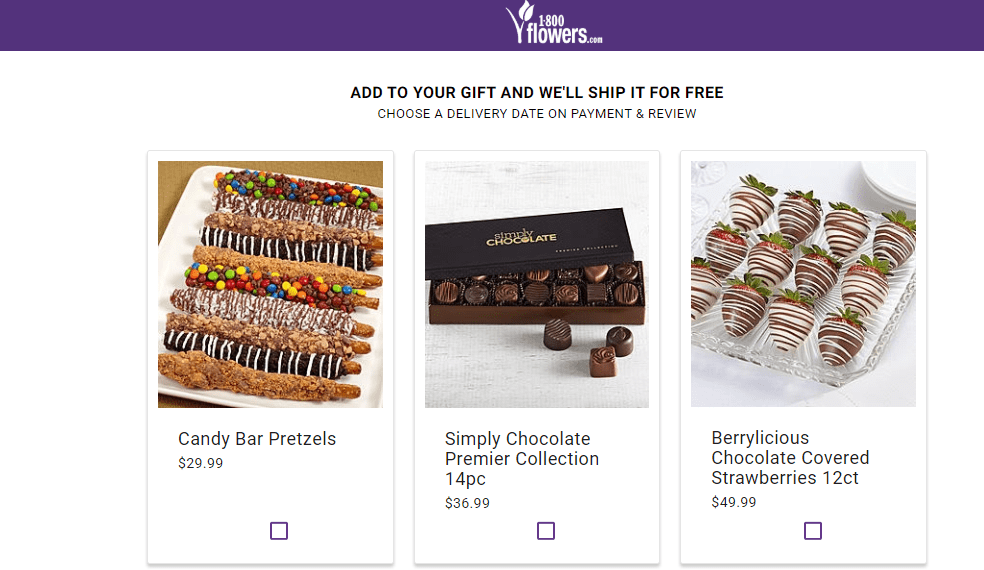
Flowers that model my personal hair color goals and chocolate pretzels without an additional shipping fee? Yes, please.
For another example, take a swing by
Xfinity
. If you’re in the market for internet service, they’ve got upsells and cross-sells for you on the same page.
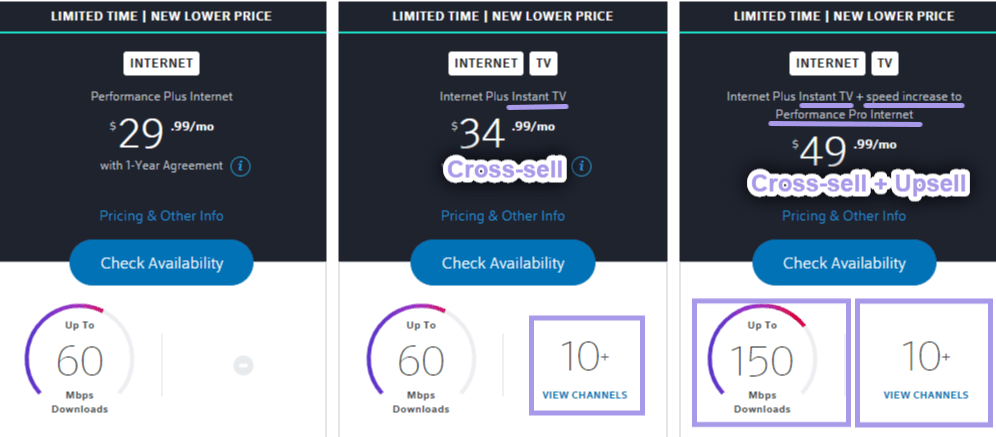
And since each successive option is only slightly more expensive than the last, it’s a brilliant move on their part. $5 more a month for streaming access to the major networks isn’t a hard sell.
Now that we’ve thoroughly eliminated any ambiguity between upsells and cross-sells, here are four tips — some common, some not-so-much — to make the most out of these sales strategies.
Как увеличить средний чек: приемы для B2C
Классические Up-Sell и Cross-Sell
Up-sell — продажа более дорогого товара. Например, человек приходит в ваш магазин фототехники. Смотрит профессиональный фотоаппарат Nikon конкретной модели. Продавец ему предлагает модель на 10% дороже, убеждая в том, что это новинка — лучше по характеристикам, возможностям.
Cross-sell — продажа других, дополнительных товаров или услуг. Например, тот же менеджер может сразу к камере предложить приобрести карту памяти, дополнительный аккумулятор, сумку для фотоаппарата. В Cross-sell можно использовать не только физические товары. Например, за 15% от стоимости товара можно предложить расширенную гарантию или дополнительный сервис.
Так, например, в сети магазинов MOYO предлагают расширенную гарантию и экстра замену за дополнительную сумму
Идеи, как увеличить средний чек в розничных продажах:
- продать не просто химчистку дивана, а с дезинфекцией (химчистка на дому, up-sell);
- к услуге свадебного визажа продать укладку (салон красоты, cross-sell);
- предложить не просто дизайн-проект, а дизайн интерьера с авторским надзором за строителями (студия дизайна, up-sell);
- при продаже детской игрушки за дополнительную плату предлагать подарочную упаковку (розница, cross-sell).
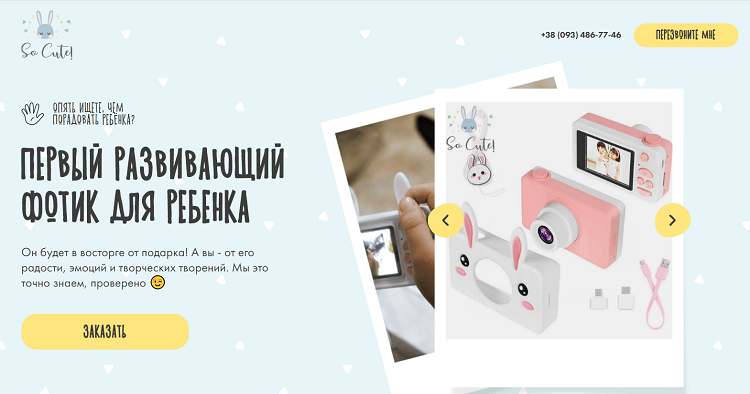
К слову, последний вариант с упаковкой товара — это один из наших последних кейсов. Для компании So Cute мы разработали Умный лендинг и запустили Продвижение. Они предлагают основной товар — детский фотоаппарат + упаковку, декор за доплату.
Первая рекламная кампания со $170 рекламного бюджета дала 21 лид, из них 19 продаж на $1197. ROMI проекта — 617%.
Точечные приемы для увеличения среднего чека
Они могут быть по сути как up-sell и cross-sell, но в других формах или с другими подходами. Ниже примеры проверенных вариантов.
Дополнение к товару
Известный вариант продажи в рознице, когда в магазине, салоне, бутике вам предлагают что-нибудь «просто примерить». Для примерки делового костюма даем рубашку. Потом изящно подталкиваем клиента купить и её. Когда человек выбирает новенький iPhone, говорим о том, что ему, наверное, нужно перенести контакты и данные со старого устройства и т.д.
Удачный комплект
Самый простой и быстрый способ повысить чек — сразу предложить человеку набор. По такому принципу образовались отдельные бизнес-модели и бренды. Часто комплекты делают более выгодными. То есть, бизнес снижает маржинальность от продажи, но получает свой заработок за счет объема. Это работает в самых разных сферах:
- набор косметики;
- сет суши или набор шашлыка;
- комплекс услуг в SPA;
- набор мебели для спальни.
Бесплатная доставка

Wrapping Up: Effective Cross-Selling Initiatives Lead to Increased Customer Lifetime Value
Acquiring customers is becoming more and more expensive. The glory days of super-low CPMs and dirt cheap traffic are dead and gone.
In order to offset these increasing costs and maintain a healthy bottom line, increasing the number of money customers are spending in each transaction is vital.
Some quick tips before we close off:
- Use Cross-Selling and Upselling to increase your profit from existing customers.
- Emulate practices from industry giants like Amazon and Mcdonald’s to skyrocket your own revenue.
- Avoid overloading customers with choices while cross-selling.
- Continue testing every sales technique to optimize your offers.
No matter if you’re building a make-up brand or an electronics retailer, cross-selling is proven to boost cart values. More than that, though, cross-selling can help deliver a better customer journey by enhancing your customer’s original order.
So, if you haven’t implemented cross-selling in your store yet, now is the perfect time to start.
Now over to you — how do you ask customers if they’d ‘like fries with that?’ Have you any upselling tips for other merchants? Let us know in the comments section below!
(And if you found this guide helpful, make sure to check out some of the other content on our blog!)
What is cross-selling?
Cross-selling is when you offer related or coordinated products during a transaction. Like upsells, they can and often do include discounts, but are not required for it to qualify as a cross-sell.
This is usually where things start to get a little convoluted. Going back to the Mcdonald’s example — it’s around lunch when I’m writing this — the fries and drink that come in a “meal deal” are the cross-sells.
For the linens retailer, selling pillowcases in the same size and color to go alongside the sheets would be a cross-sell, but not an upsell.
Put another way, if upsells are the upgrades to the original product, then cross-sells are the accessories.

Cross-selling works because it plays on two critical factors: familiarity and simplicity.
On the familiarity side,
59% of customers
prefer to buy from brands they already know when it’s time to add a new product. Cross-selling offers those new products in an environment that’s familiar, and as such, comfortable.
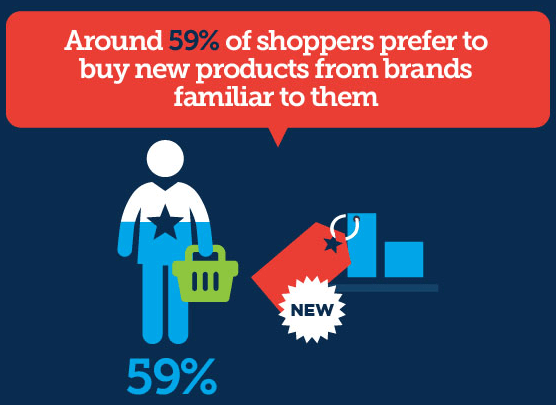
Moreover, if cross-selling is backed with
effective customer research
— and it should be, there’s nothing in marketing that works without knowing your customer — it provides a two-way benefit.
Not only do you have the opportunity to make more on a sale, but you also have the ability to provide additional products to solve your customers’ challenges.
As for the simplicity factor of cross-sells, that comes down to cognitive fluency (sometimes also called
processing fluency
).
You see, humans prefer simple and painless. The easier something is perceived to be, the more enjoyable it is for us to make decisions about it. User experience designers often leverage cognitive fluency to make decisions faster and easier for users.
The more cognitively fluent something is — say, a font choice —
the faster the user processes
the information and moves onto the next action.
As you can probably guess, using that same propensity for simplicity in marketing shortens the window between consideration and conversion.
But rather than tell you, let’s walk through an example.
Say that you decide to buy a high-quality camera to start photography as an
online side-hustle
or a hobby.
It comes at a pretty penny, so it takes a lot of time and effort mentally to learn about lens types, how lighting plays into photography, and which camera works best with which image processing software.
You finally find a camera you want:
a Nikon COOLPIX on Amazon
.

You go to add it to your cart, ready to check out, when lo-and-behold, you’re offered the accessories you need to make the most out of your camera at a discount.
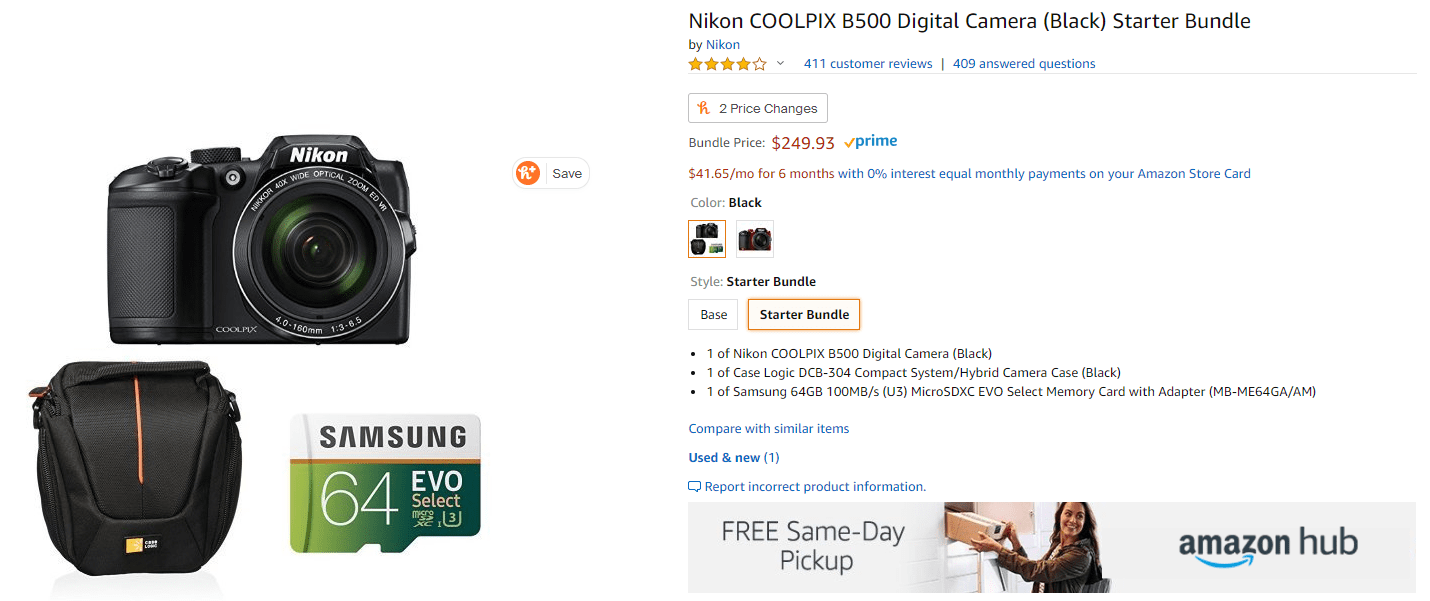
You’ve already committed to buying this camera from this retailer, so it’s familiar, and if it’s done right — as it is in the above case, where the pieces are all justified additions to the core product — it’s simple.
You’re going to need those things anyway, right? Better to save money now and ante in for the additional pieces while you’ve got a deal on the table.
Basically, cross-selling works because it gives buyers an opportunity to be lazy with their decision-making, and buyers love being lazy. (Self thoroughly included.)
The key to making this effective for you is, as most things are in business, keeping your cross-selling approach as customer-centric as possible.
Do that, and you could end up like the high-tech marketing agency Merkle’s client who
raised profits by $50 million
with a customer-centric approach.
Hopefully, the delineation between upsells and cross-sells is clearer at this point, but just in case it’s not, let’s take a (quick) look at two online companies that do both upsells and cross-sells.
Рекомендации по повышению эффективности кросс-продаж
Теперь мы знаем, как писать письмо о допродаже и выбрать подходящие продукты
На что же обратить внимание при составлении коммерческого предложения, чтобы оно действительно сработало? Вот несколько советов:. Изучите действия посетителей на сайте
Изучите действия посетителей на сайте.
Просмотрите путь их навигации по разделам, где люди побывали в первую очередь. Так вы поймете, что предложить клиенту в дополнение к покупке и как улучшить географию ресурса.
Для контроля поведения можно выбрать любой аналитический веб-сервис. Из популярных – бесплатный Google Analytics или «Яндекс.Метрика». Необходимо интегрировать счетчик (фрагмент кода) в HTML-разметку сайта, чтобы сервис отслеживал, откуда переходит посетитель (страна, город, браузер), сколько времени находится на страницах, что просматривает чаще всего, куда перемещается и т. п. Например, используя «Вебвизор» в «Яндексе», вы увидите, как ведет себя пользователь в реале (работает мышкой, нажимает на кнопки и др.).
Необходимо понимать, какую болевую точку закрывает ваш продукт или услуга. Тогда намного проще подобрать сопутствующие товары, которые усилят пользу от покупки. Исследуйте нуждаемость своей целевой аудитории, используя эту статью. Составьте список основных характеристик и сделайте портрет для каждого сегмента.
Побуждайте человека к быстрому решению.
Организуйте для него сопутствующую покупку в один клик, не уходя от основной задачи. Для этого рекомендуемые товары должны быть в поле зрения заказчика, чтобы долго не прокручивать страницу. Подробное описание поместите во всплывающие окна, которые появятся при наведении курсора мыши на товар. Тут же установите интерактивную кнопку «Купить».
Пользуйтесь авторитетностью чужого мнения.
Продемонстрируйте, что с выбранным продуктом приобрели другие покупатели. Или покажите, что в данном случае советует купить производитель (расходные материалы, сопутствующие предметы). Среди других товаров этой группы их лучше выделить каким-нибудь значком. Так, к телефонам марки Xiaomi дополнительно предложены наушники различных фирм. Однако на родных наушниках самой компании «Сяоми» стоит знак «Лучший выбор производителя».
Показывайте сочетание товаров.
Если при оформлении заказа вы хотите предложить клиенту кросс-продажи в страховании или других сферах бизнеса, объясните выгоду от этих двух продуктов вместе взятых. То же самое в обычных магазинах. При покупке джинсов покажите их вместе с рекомендуемым свитшотом, пусть человек увидит, как выглядит комплект. На электронных коммерческих площадках можно наложить сопутствующие товары прямо на картинку основного или разместить их тут же на странице. Если доски и очки для сноуборда распределить по разным категориям, шанс их продать в наборе резко упадет.
Сергей Азимов убойные фишки в продажах!
Выбирайте удачное место.
Если в ассортименте магазина есть универсальные товары, релевантные ко всем покупкам, разложите их поближе к кассе и местам с высоким трафиком клиентов. Простую вещь, которая не нуждается в объяснении функционала, многие без колебаний положат в корзину, не дожидаясь совета продавца. Это повышает шансы импульсивных кросс-продаж.
Подключайте стимул.
Привлекайте внимание к сопутствующим товарам посредством мотиваторов. Это может быть бесплатная доставка, подарочная упаковка на дополнительную вещь и др
Только проверьте, чтобы стимул не обошелся вам дороже прибыли от самого кросс-сейла.
Предварительное упоминание.
Независимо от времени, необходимого клиенту для решения о сделке, старайтесь как можно раньше показать ему товары, которые вы хотите допродать. Если вы задержите кросс-предложение, человек может определиться с бюджетом своей покупки и сочтет ваши советы неуместными. Совсем необязательно в начале разговора описывать сопутствующие товары. Это будет подготовительным этапом к вашему коммерческому предложению, озвученному чуть позднее, когда клиент будет к нему готов и правильно воспримет ваши действия.
Увеличение прибыли через дополнительные продажи посредством up sell, down sell и cross sell!
Делающему покупку клиенту продать что-то ЕЩЁ ГОРАЗДО ЛЕГЧЕ, чем заполучить нового покупателя. Практически все умелые продавцы это хорошо знают и постоянно зарабатывают и на ДОПОЛНИТЕЛЬНЫХ ПРОДАЖАХ — в довесок, в придачу. Пользуетесь ли Вы таким способом для получения дополнительной прибыли? Возможно, Вы принадлежите к тому большинству блоггеров и владельцев сайтов, что слышали о дополнительных продажах, но в своей практике не применяют. И, следовательно, Вы несёте потери в том смысле, что не получаете дополнительную прибыль, как правило, от 20% до 80%. Хотя организация дополнительных продаж для Вас не потребует больших усилий.
Для начала разберёмся с терминами, которые нередко употребляются в работах о дополнительных продажах. Up sell — вид продажи, когда вместо одного товара предлагается более дорогой (в качестве заменителя). А при down sell заменителем выступает более дешёвая вещь. При up sell и при down sell мы имеем продажи СХОЖИХ товаров (заменителей), которые отличаются между собой качеством, некоторой функциональностью и ценой. Но они в употреблении предназначены для одной и той же цели. В случае с cross sell мы имеем дело с дополнительными и сопутствующими продажами, когда К УЖЕ КУПЛЕННОМУ товару клиент приобретает что-то ещё, в придачу. Статистически давно и везде доказано, что перечисленные виды продаж увеличивают прибыль СУЩЕСТВЕННО. Однако многие владельцы сайтов и блогов, имея возможность использовать up sell, down sell и cross sell, её не реализуют. Почему? Не нужны деньги?
Summary
And there you have it!
You now know what upselling and cross-selling are, and how to use them to boost your average order value and grow your revenue.
Remember, when creating your upsell and cross-sell offers:
- Always put the customer experience first
- Only promote the most relevant and appealing offers
- Keep your upsell offers to less than 25% of the total cart value
You get three chances to upsell and cross-sell to your customers. These are before they purchase, during the checkout process, and when they purchase.
Be sure to use them all.
And, start with upselling first — remember, upselling performs 20 times better than cross-selling on product pages.
Lastly, don’t forget to take advantage of the incredible apps available on the Shopify App Store.
Do you have any questions about upselling or cross-selling? Let us know in the comment section below – we read all of them!
Want to learn more?
- 10 Ways to Increase Average Order Value
- The Complete Guide to Crowdfunding: The What, Why, Where, and How
- 20 Tricks for Optimizing Your Online Store
- How to Get More Sales With Ecommerce Conversion Optimization
How to Cross-Sell
Much like upselling, strategies for cross-selling are unique to each individual sales team and their target market.
That being said, the following is a general set of steps that can get your team started in creating a cross-selling framework.
1. Make Data-Driven Suggestions
Start by analyzing your current customer base, especially those that were receptive to a cross-sell effort and purchased additional products. How much better are they doing now that they’re your loyal customer? How did their performance improve once they adopted additional products?
Wherever you can, use real numbers, case studies, and KPIs to demonstrate just how much value your products offer to users.
2. Ask Probing Questions
It’s very important that salespeople learn how to ask effective open-ended and probing questions throughout the sales process.
These kinds of questions can shed light on additional problems or pain points the prospect might be facing that can be easily solved with another one of your offers.
3. Consider a Pitch at the Point of Sale
Cross-selling offers a little bit more room to push complementary products directly at the point of sale. This is especially effective if, throughout the sales conversation, you heard the prospect mention additional pain points that can be solved with another one of your products.
The theory here is that, assuming the prospect is likely very close already to agreeing to purchase, they may be more willing to agree to additional purchases — especially ones that will solve additional problems for them. Unlike an upsell, a cross-sell offers the attractive “killing two birds with one stone” solution.
4. Leverage Promotions
Cross-sells are especially attractive to consumers when there’s an opportunity to take advantage of a promotion or a sale.
If you have a special offer on a product related to the one your prospect wants to purchase, mention it during or after the sales process.
5. Follow Up
Try to remember that a “no” in sales does not always mean “no” forever — especially when it comes to cross-selling products. Many customers will eventually come to the conclusion that they do, in fact, need the additional complementary products that you’re offering.
That’s why following up is so important. If your prospect or customer isn’t quite ready for a cross-sell, schedule a time to follow up with them at a later date. Eighty percent of sales require five follow-ups before a prospect agrees to purchase, so don’t throw in the towel too soon.
Automate your follow-upSend personalized follow-ups at scaleTry Yesware Free
Identify and set up products for cross-sell or up-sell
Use this procedure to identify and set up products that are eligible for cross-selling or up-selling.
-
Click Product information management > Common > Released products.
-
Select the product to which you will add an eligible cross-sell or up-sell product.
-
On the Action Pane, on the Setup tab, click Show up-sell/cross-sell items for an item.
-
In the Up-sell/cross-sell items form, in the Linked item field, select the products to be offered as cross-sell or up-sell items.
-
In the Priority field, enter a number that identifies the priority of up-selling or cross-selling this product. For example, there might be two linked products that are eligible for either up-selling or cross-selling: item 1010 and item 1012. If you have twice as much of product 1010 in stock as you have of product 1012, you might indicate that cross-selling product 1010 is the highest priority, because you want to reduce the inventory count of that product.
-
Select whether the product is a cross-sell or up-sell product.
-
Optional: In the Rule name field, enter the rule that is associated with this product.
-
On the Script tab, click Add to add a script or note that can be read or spoken during the sale.
-
Select the Active check box to indicate that the script or note should be shown to the customer service representative during the sales process.
Define variables
-
Click Sales and marketing > Setup > Up-sell/cross-sell > Variables.
-
In the Up sell / cross sell rule details form, click Create a new record and enter a name for the variable.
-
In the Variable table field, select the table that contains the field variable, and then enter a brief description of the field.
For the example above, you would select CustGroup, because that is the table that contains customer group numbers.
-
In the Field field, select the field whose value will be used as the variable.
For the example above, you would select CustGroup, because that is the field where the customer group number is stored.
Cross-Selling Examples
There are many ways to cross-sell products, regardless of your industry or target market. Let’s take a look at a few examples.
Here’s another look at a razor company. The original intended purchase here is a razor; the cross-sells are the shaving brush and the shaving serum.
Let’s take a look at another example from a physical product.
In the image below, the buyer is in the process of adding an iPad to their cart. Apple offers them three cross-sells that would complement their iPad purchase: a pencil, a keyboard, and a case that all work with the chosen product.
Here’s an example of cross-selling for software products. Salesforce offers several add-ons to their standard CRM offering. The cross-selling offers below include a billing feature, a sales cloud, and a marketing automation platform.
Each of the Salesforce cross-sells complements the original CRM purchase and are add-ons that the customer might otherwise go on to purchase on their own at a later date.
Benefits of cross-selling and upselling
Cross-selling and upselling are often (and mistakenly) seen as unethical practices to squeeze more sales out of the customer.
As a marketing strategy, however, cross-selling and upselling should be used to ‘help customers win’. It’s about making recommendations that might better meet a customer’s current needs and aiding them to make a choice by being fully informed about their options.
Remind Bob to buy some batteries along with his new wall clock
Jack might be looking for something more powerful than an i5 processor, show him the i7, too.
So how do cross-selling and upselling help you as a marketer?
Increases customer retention
Leaving aside impulse buys, customers buy products and services to solve a problem. They are aware of the problem, but might not be aware of the best solution to the problem.
Steve Jobs was right when he said ‘People don’t know what they want until you show it to them.’ Upselling or cross-selling done right helps the customer find more value than they were expecting. It can increase revenues by up to 43%, thereby improving your customer retention and repeat purchases.
Increases average order value and lifetime value
Cross-selling and upselling increase your overall order value and average order value, creating revenue and profit at a very low incremental cost. You’ve already spent valuable marketing dollars to get the customer to your eCommerce store, so maximizing order value is key to ROI.
A Marketing Metric study reports that the probability of selling to an existing customer is 60-70%. The probability of selling to a new prospect is 5-20%. Upselling to existing customers is a great strategy to boost lifetime value.
Lowered customer acquisition cost
Upselling and cross-selling strategies offer a great advantage. As you sell products in bundles and push for upgrades for a high-intent lead, you get more out of a single campaign instead of running a separate campaign for an individual product or an upgrade. Thus, it helps to reduce the cost of acquiring new customers.
Businesses can optimize their marketing efforts with upsell and cross-sell, reaching a larger audience and getting the most out of each customer interaction. This approach saves resources and eliminates the need for separate campaigns for different products or upgrades, resulting in significant cost savings.
If you wish to learn more about motivating your visitors to make a purchase decision, listen to our insightful talk with Mogens Møller on the VWO Podcast.
10 способов кросс-продаж
Товары ассортиментного ряда отлично сочетаются между собой. Для продвижения техники cross-selling достаточно связать несколько товарных групп так, чтобы сопутствующая покупка улучшала свойства основной
Не забывайте, что дополнительная вещь должна стоить гораздо дешевле, иначе клиент не оценит важность главного приобретения.
Выбирайте для дополнительных позиций товары импульсного спроса. Допустим, при реализации смартфонов перед кассой лучше разложить брелоки, разнообразные наклейки для телефонов и т
д.
Настройте свой интернет-ресурс на кросс-продажи-2020. К примеру, тем, кто смотрел у вас айфоны, выдайте в рекомендациях полезные аксессуары к этим моделям.
Советы и предложения. Если человек приобретает в вашем магазине основной продукт, посоветуйте ему сопутствующий, объясняя, что недавно этот же комплект был куплен дважды. Отличный метод, оправдавший себя в продажах мебели, одежды и в онлайн-торговле.
Стимулирование спроса. Давайте людям скидки при покупке нескольких товаров, подарки за установленную сумму чека.
Мнение специалистов. Спросите у экспертов, с чем лучше совместить главный продукт для получения максимального дохода. Пример – набор косметики для волос (шампунь + бальзам или маска).
Второй товар в подарок или с большой скидкой. В действительности человек оплачивает два продукта, где в цену основного входит стоимость дополнительного. Учитывайте, что последний должен стоить не больше 10 % ключевой покупки. Этот способ выгоднее применять в ассортименте, где спрос считается неэластичным.
Используйте воронку продаж. Ключевой принцип cross-sell – продать дополнительный товар максимальному количеству клиентов.
Метод мерчандайзинга повысит ваши перекрестные продажи. Располагайте сопутствующую продукцию в одной и той же зоне. Перемещайте полки с основными и сопутствующими изделиями либо покажите варианты сочетаний на витрине.
Разработайте листовки с общей рекламой. Таким образом зачастую поступают супермаркеты. Их предложения выглядят примерно так: «Купите чипсы и получите пепси-колу бесплатно». Подобные приемы вызывают резкий рост продаж. Фактически подарка нет, поскольку стоимость напитка уже заложена в цену чипсов.
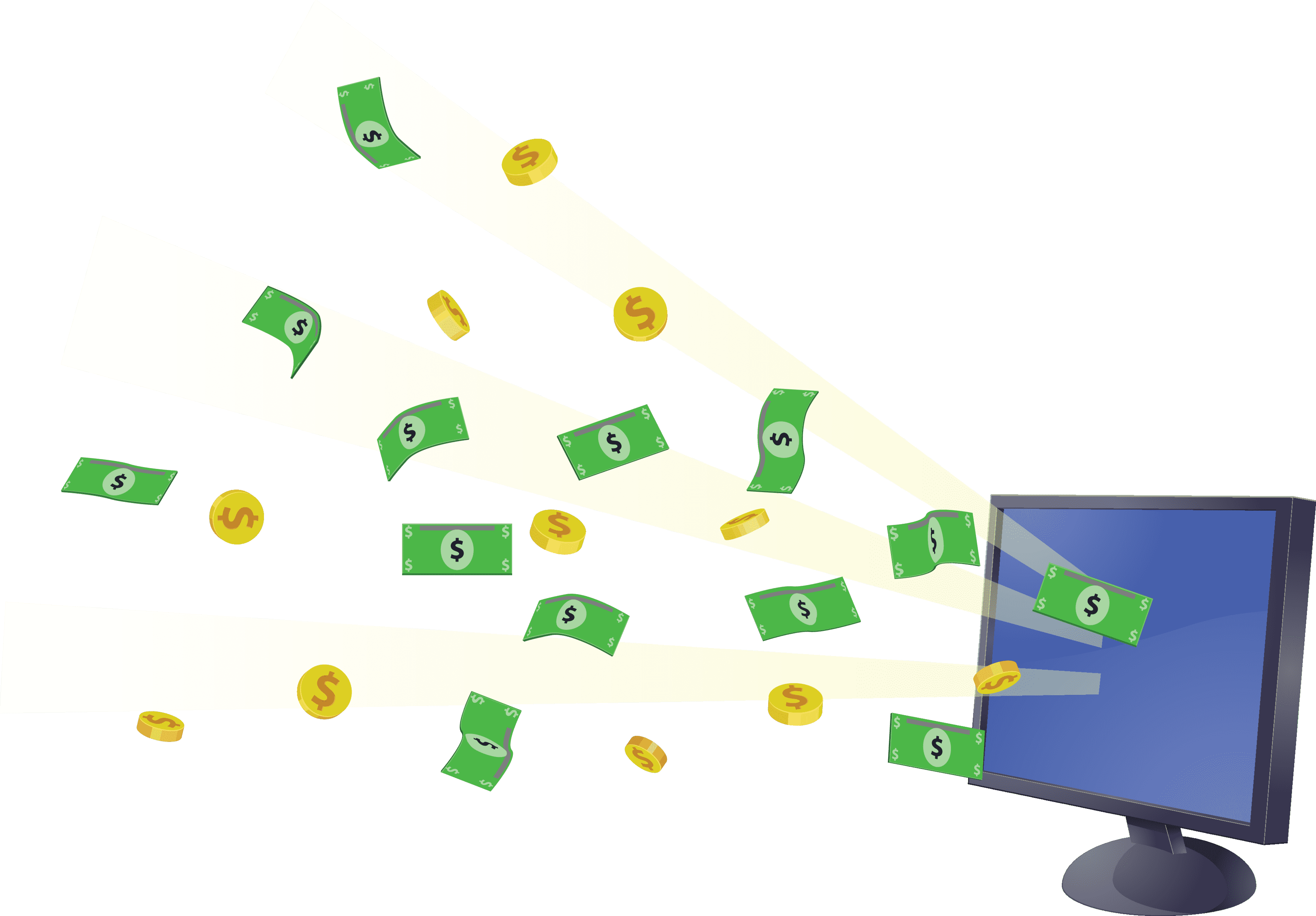



















![Cross-selling & upselling email examples [+ subject lines]](http://susaninskaya.ru/wp-content/uploads/0/c/a/0ca41afa776f19fbd47f63ae2cd9c5cf.jpeg)









